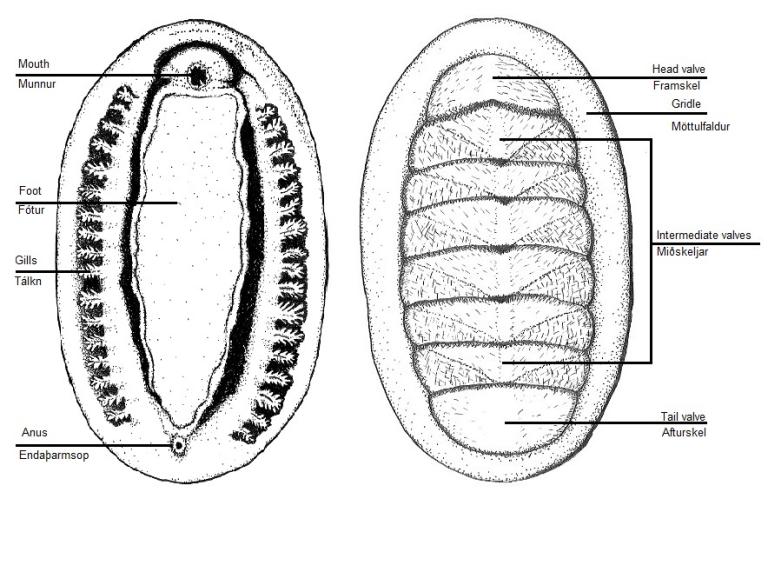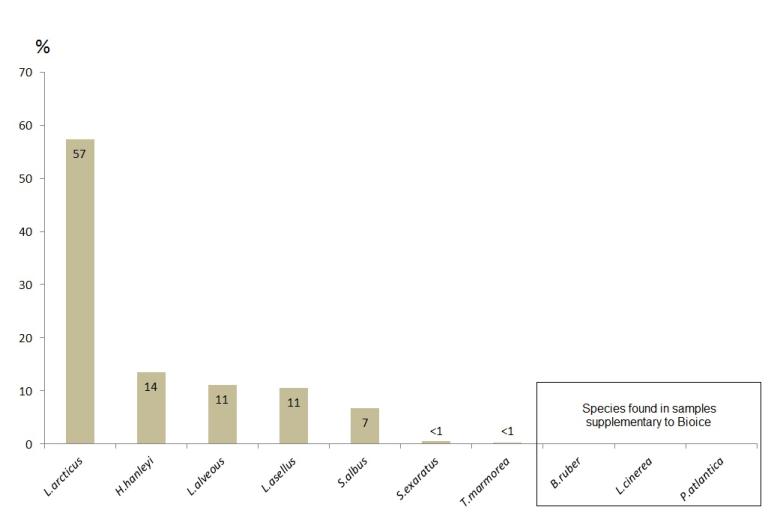
Almennt
The polyplacophorans, or chitons, are marine molluscs. The body is bilaterally symmetrical, flattened and broadly oval. The upper half is covered with eight shell plates arranged in a simple row, instead of a snail house or a cockle shell. About 600 species of chitons are found worldwide in all oceans on rocky substrates, and of these ten are reported from Icelandic waters.
The first report of Polyplacophorans in Icelandic waters is by Olafsen & Povelsen in 1772, which mentions Chiton punctatus (= Tonicella marmorea O. Fabricius). Mohr (1786) discovered two more species of the fauna of Iceland: Chiton ruber (= Boreochiton ruber Linnaeus) and Chiton albus (= Stenosomus albus Linnaeus). Gmelin (1788) reported Chiton islandicus Gmelin, which is either synonymous to Leptochiton asellus (Gmelin, 1791) or L. sarsi Kaas, 1981. Two more specie were reported in 1919 by Bardarson: Lepidopleurus arcticus G.O. Sars (= Leptochiton arcticus G. O. Sars) and Callochiton laevis (Montagu) (= Callochiton septemvalvis Montagu), and in 1944 Óskarsson added Hanleya abbysorum (M. Sars) (= Hanleya nagelfar Lovén) and in 1949 Knudsen added Hanleya hanleyi (Bean). Knudsen (1949) expressed doubts of the records of Leptopleurus arcticus and Callochiton septemvalvis, because only specimen of L. arcticus was found on the shore near Stykkishólmur, and the report of C. septemvalvis is from Bardarson (1920), which in turn was informed on the occurrence of C. septemvalvis by Mr. Gröndal, although no specimen has ever been found. Óskarsson in 1960 and 1971, added two more species to the Icelandic polyplacophorans: Lepidochitona cinerea L. (= Leptochiton cinereus (L.)) and Stenosemus exaratus G.O. Sars (= Lepidochiton exarata G.O. Sars).
The BIOICE project is a comprehensive inventory of benthic invertebrates within the 200 mile economical zone of Iceland. Sampling started in 1992 and was completed in 2004, which resulted in 1032 benthic samples of which 197 samples (19%) contained chitons. Four kinds of benthic sampling gears were used: Agassiz trawl, Triangular dredge, modified Rothlisberg & Pearcy epibenthic sampler (Brattegard & Fosså 1991), and the Sneli detritus sledge (Sneli 1998). The Bioice samples yielded 1768 chiton specimens, representing eight species of chitons, of which two are new record in Icelandic waters: Leptochiton alveolus and Placiphorella atlantica. However, the previously known species Leptochitona cinerea and Boreochiton ruber were not found in the Bioice samples, most probably because those species live in waters that are shallower than 50 m, which were not sampled to any extent. The chiton Callochiton septemvalvis, which occurs in deeper waters, was not found in the extensive sampling of the Bioice program, and is therefore not considered as a part of the chiton fauna of Iceland. All chitons sampled during the BIOICE program are registered in the Bioice database and voucher specimens are depostied in collection of the Icelandic Institute of Natural History. Questions concerning loan of material or other matters are to be directed to the Icelandic institute of Natural History, IS-210 Gardabær, Iceland (gg@ni.is)
Identification
Chitons have eight shell plates, called valves, which are often very colourful and variously sculptured and cover the upper part of the animal. Surrounding the vales is a fleshy girdle, which is often covered with scales, hairs, or spicules, which vary between species. The underside has a strong foot, with multiple gills in a pallial groove on either side of the foot. The mouth has a radular tongue used for scraping algae.
The head valve is important diagnostic feature of the species. The front of the head valve may have an insertion plate embedded in the girdle tissue. Some species does lack an insertion plate but if present, it can be either plain or toothed. The upper surface of the girdle may be covered with various granules or scales, and different kinds of spines.
The number of gills, ctenidia, usually increases with age. Their arrangement, however, is characteristic fort the species, and may approximately occupy the whole length of the pallial groove (holobranch condition) or only the posterior part (merobranch condition).
A simple Key to the Icelandic species:
1. Head valve with no insertion plate present or the insertion plate is plain.................2
- Insertion plate with slits..................................................................................5
2. Head valve with no insertion plate....................................................Leptochiton
- Head valve with a plain insertion plate .......................................Hanleya hanleyi
3. Animal more than twice as long as broad; central areas of intermediate valves with well separated granules in an irregularly quincuncial pattern.................................................................................Leptochiton alveolus
- Animal oval, about 1.5 x as long as broad; moderately elevated......................4
4. Side slopes rather flat, girdle tissue dirty white, generally with short longitudinal dark bands or stripes, end valves and lateral areas with radiating rows of granules....................................................Leptochiton asellus
- Side slopes convex, girdle tissue yellowish, granules on end valves and lateral
areas quicuncially arranged..................................................Leptochiton arcticus
5. Girdle broadly expanded anteriorly with two rows of large bristles, numerous near the front
and more scattered above............................................................Placiphorella atlantica
- Girdle not expanded in front, bristles of the same size both in front and
along the sides of animal..............................................................................6
6. Upper surface of girdle covered with broad, smooth shells..................................7
- Upper surface of girdle with small, minute granules...........................................8
7. Valves smooth and glossy to the naked eye................................Stenosemus albus
- Valves with fine radiating and concentrical grooves, giving them
a granulose appearance.......................................................Stenosemus exaratus
8. Girdle with a conspicuous marginal fringe of stout, conical spicules striated at the tip.....................................Lepidochitona cinerea
- Girdle without a conspicuous marginal spicule fringe...........................................9
9. Girdle with small, closely packed granules....................................Boreochiton ruber
- Girdle with minute, widely separated granules...........................Tonicella marmorea
Systematics
The systematic list below is compiled with reference to the ERMS database and relevant littereature on Icelandic polyplacophorans. Each species is treated on separate webpages, providing valid name, author and publication year; relevant synonyms are mainly after ERMS and literature on Icelandic polyplacophorans; reference to good descriptions of the species in indicated; previously published records from Iceland are listed; dominating bottom sediments and water mass characteristics in the areas where the species was found; ranges of depth, measured and estimated water temperature range of the near-bottom water; general depth range of the species, and their general distribution.
Class: POLYPLACOPHORA
Subclass: NEOLORICATA
Order: LEPIDOPLEURIDA
Family: LEPTOCHITONIDAE
Genus: Leptochiton Gray, 1847
Leptochiton alveolus (M. Sars MS, Lovén, 1846)
Leptochiton arcticus (G. O. Sars, 1878)
Leptochiton asellus (Gmelin, 1791)
Family: HANLEYIDAE
Genus: Hanleya Gray, 1857
Hanleya hanleyi (Bean, 1844)
Order: CHITONIDA
Family: ICHNOCHITONIDAE
Genus: Stenosemus von Middendorff, 1847
Stenosemus albus (Linnaeus, 1767)
Stenosemus exaratus (G.O. Sars, 1878)
Family: MOLPALIIDAE
Genus: Placiphorella Dall, 1879
Placiphorella atlantica (Verrill & Smith, 1882)
Family: TONICELLIDAE
Genus: Lepidochitona Gray, 1821
Lepidochitona cinerea (Linnaeus, 1767)
Genus: Tonicella Carpenter, 1873
Tonicella marmorea (O. Fabricius, 1780)
Genus: Boreochiton G.O, Sars, 1878
Boreochiton ruber (Linnaeus, 1767)
Cite this page as: Jon-Arne Sneli and Gudmundsson, G. (2018). Polyplacophora (Nökkvar). http://ni.is/biota/animalia/mollusca/nokkvar-polyplacophora
Literature
Bardarson, G. 1919. Sæ-lindýr vid Island - Skýrsla islands Náttúrufrædisfelag 1917-1918. Reykjavik
Bardarson, G. 1920. Om den marine molluskfauna ved vestkysten af Island - Kgl. Danske Videnskabers Selskab Biologiske Meddelelser (2): 3.
Dons, C. 1933. Om utbredelsen av Hanleya nagelfar - Klg. Norske Videnskabers Selskab Forhandlinger 5: 151 - 153.
Gmelin, J. F. 1788. Caroli a Linné Systema Naturae, ed. 13
Jeffreys, J. G. 1865 - 1869. British Conchology vols 3 & 5 London
Johansen, A. C. 1902. On the Mollusca between tide marks at the coast of Iceland - Videnskabelige meddelelser Dansk Naturhistorisk Forening
Kaas, P. & R. A. Van Belle, R.A. 1985a. Monograph of living Chitons, vol. 1, Brill, dr. W. Backhuys, Leiden, 240 pp.
Kaas, P. & R. A. Van Belle, R.A. 1985b. Monograph of living Chitons, vol. 2, Brill, dr. W. Backhuys, Leiden, 198 pp.
Kaas, P. & R. A. Van Belle, R.A. 1990. Monograph of living Chitons, vol. 4, Brill, dr. W. Backhuys, Leiden, 298 pp.
Kaas, P. & R. A. Van Belle, R.A. 1994. Monograph of living Chitons, vol. 5, Brill, dr. W. Backhuys, Leiden, 402 pp.
Knudsen, J. 1949. Amphineura - Zoology of Iceland 4 (59): 1- 11.
McLean, J. H. 1962. Feeding behavior of the chiton, Placiphorella. Proccedings of the Malacological Society of London 35: 23-36.
Mohr, N. 1786. Forsøg til en Islandsk Naturhistorie. Havniae
Mørch, O. A. L. 1868. Faunula Danicae Prodromus. Havniae
Olafsen, E. & B. Povelsen 1772. Reise igiennum Island. Sorøe
Óskarsson, I. 1960. Nýjungar um íslensk lindýr. Náttúrufrædingnum 30: 176-187.
Óskarsson, I. 1971. Nýjungar um íslensk lindýr. Náttúrufrædingnum 41: 144-152.
Sars, G. O. 1878. Bidrag til kundskaben om Norges arktiske fauna, Mollusca regionis Arcticae Norvegiae. Universietsprogram for første halvaar 1878. Christiania, 466 pp., 52 pl.
Schrøder-Nilsen 2009. Morphological and genetic variation in Hanleya nagelfar and Hanleya hanleyi (Mollusca: Polyplacophora) in the Northern European Atlantic and the phylogenetic position of Hanleyidae based on nuclear and mitochondrial genes. Thesis for the degree of Master of Science, Marine Biodiversity at Department of Biology, University of Bergen, 92 pp.
Sneli, J.-A. 1992. Placiphorella atlantica (Mollusca, Amphineura) in the North Atlantic. Sarsia 77: 143-145.
Todt, C., P. Cárdenas & H. T. Rapp 2009. The chiton Hanleya nagelfar (Polyplacophora, Mollusca) and its association with sponges in the European Northern Atlantic. Marine Biology Research 5(4): 408-411.
Warén, A. & A.B. 1991. Hanleya nagelfar, a sponge-feeding ecotype of H. hanleya or a distinct species of chiton? Ophelia 34: 51-70.
Myndir

Höfundur
Guðmundur Guðmundsson maí 2018